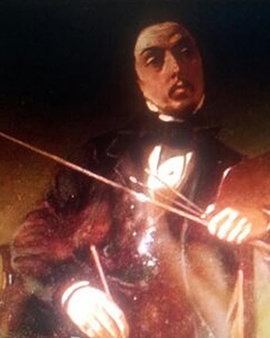


Landscape painting must not be confused with a mere nature show and has been changing constantly from antiquity to the present day. The painter Edmund John Niemann, who was attracted to this art, lived from 1813 to 1876 and consequently experienced several art epochs, to which he devoted himself more or less. Due to his age, the landscape portraitist, born in Islington, London, has both the expiring epoch of Classicism and Romanticism as well as the new epochs: Biedermeier, Realism and Impressionism. E. J. Niemann proves that landscape cannot be reduced to natural phenomena alone with a wide selection of different subjects. If the river landscapes of the Thames and the Swale near Richmond in Yorkshire are also among his favourite motifs, his broad repertoire of urban, rural and near-natural picture centres reveals the diversity of his painting.
Because of his father John Diedrich Niemann, a member of Lloyds from Minden Westphalia, Edmund was also initially a bank employee in the City of London. Only a few months later, the still young art lover was drawn out and from then on he devoted himself to art. In 1839 the landscape painter settled in High Wycombe, Buckinghamshire and from then on he painted outdoors. Already in 1844 his first works were recognized and E. J. Niemann exhibited his first work "On the Thames - near Great Marlow, Bucks" at the Royal Academy. The publication in numerous renowned galleries, such as the one mentioned above as well as the British Institution, the Royal Scottish Academy, the Royal Institute and the Paris Salon, to name but a few, prove the class of the late painter. He also founded his own exhibition in 1848, the so-called "Free Exhibition", which was later to change into "The National Institution". Although the exhibition of far more than 500 paintings and sculptures was only of short duration, it was all the more successful.
The paintings of E. J. Niemann speak their own language, without hiding which painting styles the artist felt drawn to. Thus, the romantic subjects of William Turner or Caspar David Friedrich are just as popular as the charm of realistic realism. The latter is revealed by the very realistic use of colours, which the artist knew how to approach in many different facets. However, to let the gaze wander into the distance and yet to create a transcendental relationship between dream and reality is also the focus of his painting. Thus, in the paintings "Black Castle", "View of Whitby" as well as "Evening on the French Coast" and other painting studies, the romantic dream of a pictorial magic is recognizable. Here, above all, emotional processes between viewer and picture are to be stimulated, which reveal something much larger, exciting behind nature. The colour intensity of these paintings thus exposes the effect of light in space in a very special way. This is also the way some of Edmund John Niemann's paintings are meant to be dreamed, despite their closeness to reality.

Landscape painting must not be confused with a mere nature show and has been changing constantly from antiquity to the present day. The painter Edmund John Niemann, who was attracted to this art, lived from 1813 to 1876 and consequently experienced several art epochs, to which he devoted himself more or less. Due to his age, the landscape portraitist, born in Islington, London, has both the expiring epoch of Classicism and Romanticism as well as the new epochs: Biedermeier, Realism and Impressionism. E. J. Niemann proves that landscape cannot be reduced to natural phenomena alone with a wide selection of different subjects. If the river landscapes of the Thames and the Swale near Richmond in Yorkshire are also among his favourite motifs, his broad repertoire of urban, rural and near-natural picture centres reveals the diversity of his painting.
Because of his father John Diedrich Niemann, a member of Lloyds from Minden Westphalia, Edmund was also initially a bank employee in the City of London. Only a few months later, the still young art lover was drawn out and from then on he devoted himself to art. In 1839 the landscape painter settled in High Wycombe, Buckinghamshire and from then on he painted outdoors. Already in 1844 his first works were recognized and E. J. Niemann exhibited his first work "On the Thames - near Great Marlow, Bucks" at the Royal Academy. The publication in numerous renowned galleries, such as the one mentioned above as well as the British Institution, the Royal Scottish Academy, the Royal Institute and the Paris Salon, to name but a few, prove the class of the late painter. He also founded his own exhibition in 1848, the so-called "Free Exhibition", which was later to change into "The National Institution". Although the exhibition of far more than 500 paintings and sculptures was only of short duration, it was all the more successful.
The paintings of E. J. Niemann speak their own language, without hiding which painting styles the artist felt drawn to. Thus, the romantic subjects of William Turner or Caspar David Friedrich are just as popular as the charm of realistic realism. The latter is revealed by the very realistic use of colours, which the artist knew how to approach in many different facets. However, to let the gaze wander into the distance and yet to create a transcendental relationship between dream and reality is also the focus of his painting. Thus, in the paintings "Black Castle", "View of Whitby" as well as "Evening on the French Coast" and other painting studies, the romantic dream of a pictorial magic is recognizable. Here, above all, emotional processes between viewer and picture are to be stimulated, which reveal something much larger, exciting behind nature. The colour intensity of these paintings thus exposes the effect of light in space in a very special way. This is also the way some of Edmund John Niemann's paintings are meant to be dreamed, despite their closeness to reality.
Page 1 / 1






